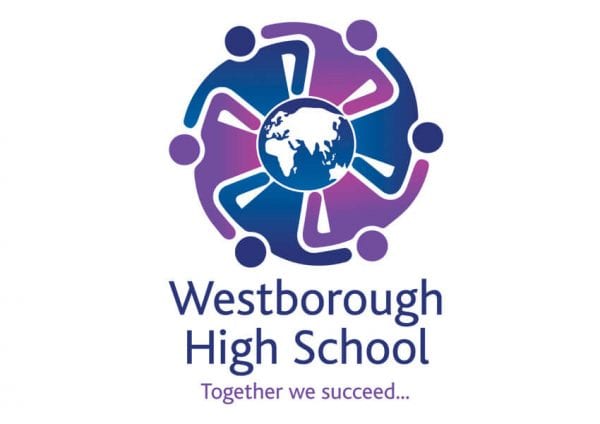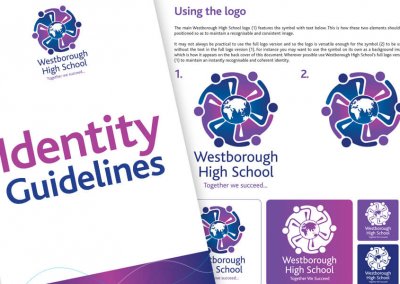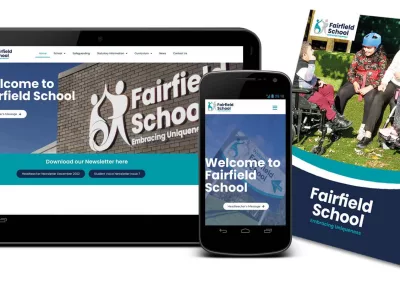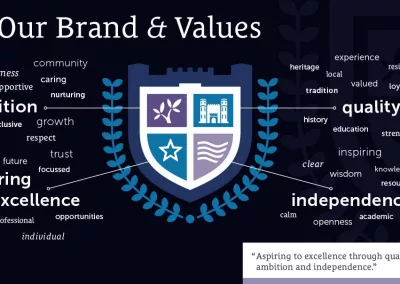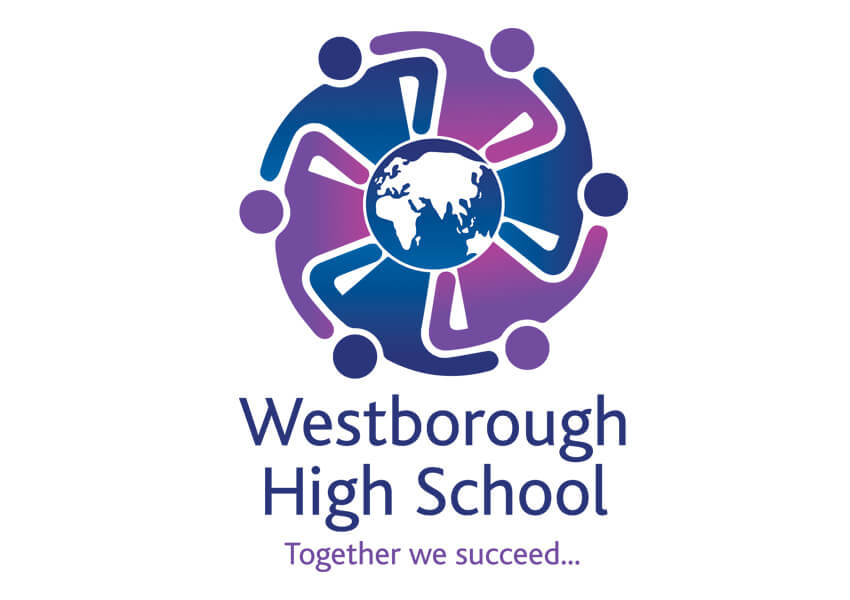Enhancing Reputation and Attracting Prospective Families
School branding goes beyond a logo or colour scheme. It shapes a school’s visual and emotional identity. A strong brand fosters pride among students, staff, and parents while creating a professional image.
Your school branding can enhance your reputation and help attract prospective families. When you develop a cohesive, recognisable identity, it instils confidence, strength, and a sense of belonging in parents and students.
From logos to wall art and signage to colour schemes and typeface, school branding shapes perceptions both inside and outside a school. But what does school branding entail? Why is it so important? How can your school develop a unique, compelling visual identity?
What is School Branding?
Your school logo is a fraction of its branding, which can be described as the collection of visual elements that identify your school. Consistency is crucial to ensure a professional and polished loom that supports your school’s values and simultaneously appeals to students, parents, and staff. Elements of branding include:
· School Logos and Icons
The foundation of your school’s branding, the logo and icon are symbols that allow people to instantly recognise it and what it stands for.
· Colours and Typography
Consistent use of colour palettes and fonts helps maintain a professional, unified look across all branding materials.
· Signage and Displays
Branded signage and school wall art make an immediate impression on visitors and create a stimulating learning environment.
· Digital Presence
Your school website, social media channels, and digital communication should align with your school’s branding for a consistent experience.
A well-defined school branding strategy fosters a strong sense of community and pride. It helps students and staff feel a deeper connection to their school, creating a positive atmosphere that enhances learning and engagement.
Why Does School Branding Matter?
A well-defined school branding strategy will deliver a strong sense of community and pride. It helps students and staff feel a deeper connection to your school, creating a positive atmosphere that enhances learning and engagement.
A strong visual identity can instil a sense of pride and belonging, boosting moral and motivation. It helps everyone to recognise the school as professional, organised, and competent.
Well-designed branding also delivers a uniform look across all internal and external touchpoints, reinforcing a positive identity within your community, and helping the school to stand out in a crowded and competitive educational landscape.
How School Branding Helps Attract Students and Families
For parents choosing a school, first impressions are crucial. A well-crafted branding strategy ensures that prospective students and families see a school as professional, engaging, and trustworthy across three key pillars:
- Visibility – Making it easier for people to identify and remember your school.
- Trust and Credibility – Parents are more likely to trust a school that presents itself professionally.
- Engagement – Supported by strong branding, your school can leverage its website, social media, and digital marketing channels to promote its ethos and academic successes effectively.
In short, a polished website with consistent branding, engaging wall displays that tell a story, and a distinctive school logo all contribute to making your school more appealing to prospective families.
Five Key Elements of Effective School Branding Design
Effective school branding design is built on several essential elements that work together to create a strong, recognisable identity.
From the school logo to digital presence, each of these elements play a crucial role, helping to reinforce values, enhance professionalism, and develop a sense of belonging.
By carefully considering these key aspects, you can develop school branding that leaves a lasting impression.
What are the five key elements of effective school branding design?
1. What makes a good school logo?
A strong school logo should be simple, memorable, and reflective of the school’s ethos. It should work well across different mediums, from uniforms to website banners.
2. What role does a school icon play?
Icons such as crests, mascots, or emblems reinforce branding by adding a recognisable symbol that complements the main logo.
3. Why do colours and typography matter?
The right colours and fonts can influence perceptions of a school. Traditional colours convey heritage and stability, while modern palettes can reflect innovation and inclusivity.
4. How can branding be applied to uniforms and merchandise?
Branded uniforms, school bags, and stationery help reinforce a unified identity and foster school spirit.
5. What is the role of digital branding?
A school’s website and social media presence should reflect its brand through consistent colours, fonts, and messaging.
What Are the Latest Trends in School Branding?
Primary school branding should be friendly, engaging, and suitable for younger children. Playful fonts, bright colours, and simple designs work well. Meanwhile, high school branding often leans towards more sophisticated designs, using bold typography, sleek logos, and a mature colour palette to convey professionalism. However, across all educational establishments, we’re experiencing three common trends:
1. Digital branding
Schools are embracing digital platforms with branded websites, social media, and interactive virtual tours.
2. Sustainable branding
Schools are incorporating eco-friendly materials in signage and merchandise to reflect their environmental values.
3. Experiential branding
Schools are investing in interactive wall art and themed environments to create inspiring spaces.
Four Steps to Develop or Refresh Your School’s Brand
Whether starting with a blank canvas or seeking to refresh your existing branding, there are four overarching steps for a successful branding project:
Step 1: Conduct a school brand audit to assess existing branding elements and identify any inconsistencies.
Step 2: Engage stakeholders in the branding process (your staff, students, parents, and school board).
Step 3: Seek professional expertise to ensure a high-quality result.
Step 4: Implement branding across all touchpoints to ensure consistency in signage, digital platforms, and marketing materials.
Enhancing Your School Branding: Where Do You Start?
Investing in your school’s branding is investing in your school’s future. At Design for Education, we specialise in school branding design, offering tailored solutions from school logos and signage to immersive wall art and displays.
If you wish to create a striking visual identity and take your school branding to a new level, get in touch with us today to discuss how we can help bring your vision to life.
More like this…
School Branding Through School Wall Art to Show Your School Values
Explore how Design for Education partnered with Sheffield Springs Academy to transform their secondary school environment with captivating wall art. This creative transformation celebrates Sheffield’s uniqueness and embraces diversity, providing an immersive and inspiring learning atmosphere for students. See how our creative design can revolutionise an educational space.
Successful Rebranding of a Multi-Academy Trust – All You Need to Know
Rebranding a Multi-Academy Trust is essential for reflecting growth, evolving visions, or modernising an outdated identity. This transformation involves aligning the Trust’s overarching goals with a cohesive brand narrative while respecting each academy’s unique qualities. Our article outlines the major challenges and a three-stage process to ensure a successful school rebranding.
School Branding Ideas That Reflect the Values and Vision of Your School
Explore school branding strategies that reflect your values and vision. Create a cohesive identity that stands out, fostering a sense of belonging and boosting your reputation in the community. You can transform your school’s image with professional branding ideas. From logos to internal displays, ensure your school’s identity resonates with students, staff, and prospective families, promoting excellence and inclusivity.

